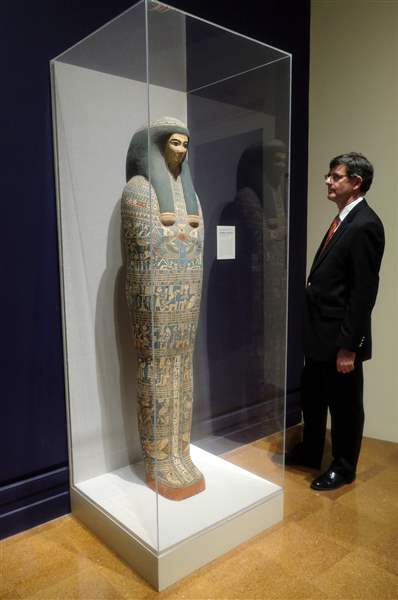http://www.toledoblade.com/Art/2018/02/02/Museum-exhibit-probes-Egyptian-culture.html
Museum exhibit probes Egyptian culture
During their travels, they stayed with other wealthy tourists at the popular Shepheard's Hotel in downtown Cairo, and purchased antiquities and objects of curiosity from nearby antiques dealer Ralph Blanchard to bring back to northwest Ohio and their newly founded museum.
"Ninety-eight percent of the objects accessioned to the (Toledo) collection through 1906 were Egyptian," said co-curator Adam Levine, museum deputy director and curator of ancient art. "[The Libbeys] were fascinated with Egypt, they were engaged with Egypt."
PHOTO GALLERY: Mummies exhibit at Toledo Museum of Art
The Libbeys were part of an early 20th century population whose curiosity with ancient Egypt was piqued after expeditions of Napoleon Bonaparte in the late 18th century.
It was on that first trip in 1906 that the couple purchased two ancient Egyptian mummies, the focal point of an exhibition that opens Saturday at the museum: An old man mummified close to the year 100 A.D. who was thought to be a laborer, and a young priest who researchers believe was only about 20 when he died and was prepared for the afterlife close to 800 B.C.
"The Mummies: From Egypt to Toledo" will remain on the museum's floor in the Canaday Gallery through May 6. The mummies have been on display before - most recently in 2004 and 2010 - but museum staff say this show stands out for its goal of humanizing a civilization and its belief in burial rites perhaps lost in the past to Egyptomania, a term referring to the recurring fascination with ancient Egypt in Western and European society.
"These were real people who existed, and these were deeply religious beliefs," said co-curator Mike Deetsch, TMA director of education and engagement.
The exhibit space is dissected to display the different paradigms of Egyptian culture in several different rooms that get narrower and less bright, until the visitor comes upon the two mummies, reverently displayed in a dimly lit room with little on the walls other than explanatory text.
"It became very poignant when we [placed] the two human remains in the space, it had a tremendous emotional impact…because we were respecting them as human remains as opposed to another object in the collection," said Claude Fixler, museum manager of installation and exhibition design, when talking about the difference between this exhibition and past shows, that focused more on the art and other educational aspects of ancient Egyptian culture.
The first few sections of the exhibition focuses on some of the objects that evolved from the fascination with Egyptian culture, including fountain pens and lead pencils in the likeness of mummies that doubled as necklace pendants, bracelets made from scarab beetles, Egyptian-centric ads promoting Egyptian lotions and wrinkle cream, movie trailers and promotional posters promising levitating mummies, and other magic sensations.
"As we meditated on this cultural shift over the past century we decided the way to reanimate the mummies as human remains, as old man and young priest, was to expose to people that their conception of what mummies are is shaped by the cultural matrix in which they live," Mr. Levine said.
As visitors wind through the displays, they will enter rooms that turn the focus to the history of ancient Egyptians, and their beliefs that everything they were connected to on Earth, they were also connected to spiritually. On display are Egyptian masks that were placed over the heads of the mummified humans, and shabtis, small wood or ceramic statues that mimicked occupations and vocations a human had in life. Ancient Egyptians believed that those statues - for example, one of a farmer - carried on those tasks for the person in the afterlife.
"This idea of passage on to the afterlife was that your life more or less existed in the afterlife as it did here," Mr. Deetsch said.
A rare showing is a wooden coffin that carried the young priest from Egypt to Toledo. Because of symbols and other markings on the wood, researchers believed that mummy to be female until DNA testing about 20 years ago deemed him to be male.
At the end of the exhibit, visitors will have a chance to give input on future display of the mummies by simply sticking a Post-it note with their thoughts onto a board. In contemporary society, the inclusion of human remains in a museum exhibition remains controversial.
"It is a challenge for us to wonder if people in 100 years' time will think what we think now. Here we are, thinking 100 years or more after the Libbeys bought, purchased human remains in 1906, that that's inconceivable now," said museum director Brian Kennedy. "If we are going to show the mummies again, let's ask the community what they think about that. And that's what we will find out in the next few months."
Contact Roberta Gedert at rgedert@theblade.com, 419-724-6075, or on Twitter @RoGedert.
-- Sent from my Linux system.

No comments:
Post a Comment